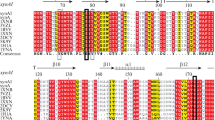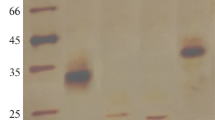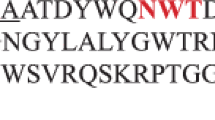Abstract
In recent years, the biotechnological use of xylanases has grown remarkably. To efficiently produce xylanase for food processing and other industry, a codon-optimized recombinant xylanase gene from Streptomyces sp. S38 was synthesized and extracellularly expressed in Pichia pastoris under the control of AOX1 promoter. SDS-PAGE and activity assay demonstrated that the molecular mass of the recombinant xylanase was estimated to be 25 kDa, the optimum pH and optimum temperature were 5.5 and 50°C, respectively. In shake flask culture, the specific activity of the xylanase activity was 5098.28 U/mg. The K m and V max values of recombinant xylanase were 11.0 mg/ml and 10000 μmol min−1 mg−1, respectively. In the presence of metal ions such as Ca2+, Cu2+, Cr3+ and K+, the activity of the enzyme increased. However, strong inhibition of the enzyme activity was observed in the presence of Hg2+. This is the first report on the expression properties of a recombinant xylanase gene from the Streptomyces sp. S38 using Pichia pastoris. The attractive biochemical properties of the recombinant xylanase suggest that it may be a useful candidate for variety of commercial applications.





Similar content being viewed by others
References
Singh S, Madlala AM, Prior BA (2003) Thermomyces lanuginosus: properties of strains and their hemicellulases. FEMS Microbiol Rev 27:3–16
Polizeli MLTM, Rizzatti ACS, Monti R, Terenzi HF, Jorge JA, Amorim DS (2005) Xylanases from fungi: properties and industrial applications. Appl Microbiol Biotechnol 67:577–591
Biely P (1985) Microbial xylanolytic systems. Trends Biotechnol 3:286–290
Silversides FG, Bedford MR (1999) Effect of pelleting temperature on the recovery and efficacy of a xylanase enzyme in wheat-based diets. Poultry Sci 78:1184–1190
Kung L Jr, Treacher RJ, Nauman GA, Smagala AM, Endres KM, Cohen MA (2000) The effect of treating forages with fibrolytic enzymes on its nutritive value and lactation performance of dairy cows. J Dairy Sci 83:115–122
Kuhad RC, Singh A (1993) Lignocellulose biotechnology: current and future prospects. Crit Rev Biotechnol 13:151–172
Figueroa-Espinoza MC, Poulsen C, Borch Soe J, Zargahi MR, Rouau X (2004) Enzymatic solubilization of arabinoxylans from native, extruded, and high-shear-treated rye bran by different endo-xylanases and other hydrolyzing enzymes. J Agric Food Chem 52:4240–4249
Hang YD, Woodams EE (1997) Xylanolytic activity of commercial juice-processing enzyme preparations. Lett Appl Microbiol 24:389–392
Subramaniyan S, Prema P (2002) Biotechnology of microbial xylanases: enzymology, molecular biology, and application. Crit Rev Biotechnol 22:33–64
Wong KKY, Saddler JN (1992) Trichoderma xylanases, their properties and application. Crit Rev Biotechnol 12:413–435
Sunna A, Antranikian G (1997) Xylanolytic enzymes from fungi and bacteria. Crit Rev Biotechnol 17:39–67
Wong KKY, Tan LU, Saddler JN (1988) Multiplicity of β-1, 4-xylanase in microorganisms: functions and applications. Microbiol Rev 52:305–317
Gilkes NR, Henrissat B, Kilburn DG, Miller RC Jr, Warren RA (1991) Domains in microbial beta-1,4-glycanases: sequence conservation, function, and enzyme families. Microbiol Rev 55:303–315
Henrissat B, Bairoch A (1993) New families in the classification of glycosyl hydrolases based on amino acid sequence similarities. Biochemi J 293:781–788
Henrissat B, Davies G (1997) Structural and sequence-based classification of glycoside hydrolases. Curr Opin Struc Biol 7:637–644
Garg AP, Roberts JC, McCarthy AJ (1998) Bleachboosting effect of cellulase-free xylanase of Streptomyces thermoviolaceus and its comparison with two commercial enzyme preparations on birchwood kraft pulp. Enzyme Microb Technol 22:594–598
Cereghino JL, Cregg JM (2000) Heterologous protein expression in the methylotrophic yeast Pichia pastoris. FEMS Microbiol Rev 24:45–66
Xiong AS, Yao QH, Peng RH, Li X, Fan HQ, Li Y, Cheng ZM (2004) A simple, rapid, high fidelity and cost-effective PCR based two-step DNA synthesis (PTDS) method for long gene sequences. Nucleic Acids Res 32:e98
Xiong AS, Peng RH, Li X, Fan HQ, Yao QH, Guo MJ, Zhang SL (2003) Influence of signal peptide sequences on the expression of heterogeneous proteins in Pichia pastoris. Acta Biochim Biophys Sin 35:154–160
Sambrook J, Fritsch EF, Maniatis T (1989) Molecular cloning: a laboratory manual, 2nd edn. Cold Spring Harbor, New York
Bailey MJ, Biely P, Poutanen K (1992) Interlaboratory testing of methods for assay of xylanase activity. J Biotechnol 32:257–270
Bhat MK (2000) Cellulases and related enzymes in biotechnology. Biotechnol Adv 18:355–383
Aristidou A, Pentillä M (2000) Metabolic engineering applications to renewable resource utilization. Curr Opin Biotechnol 11:187–198
Beg QK, Bhushan B, Kapoor M, Hoondal GS (2000) Enhanced production of a thermostable xylanase from Streptomyces sp. QG-11-3 and its application in biobleaching of eucalyptus kraft pulp. Enzyme Microb Technol 27:459–466
Beg QK, Kapoor M, Mahajan L, Hoondal GS (2001) Microbial xylanases and their industrial applications: a review. Appl Microbiol Biotechnol 56:326–338
Techapun C, Poosaran N, Watanabe M, Sasaki K (2003) Thermostable and alkaline-tolerant microbial cellulose-free xylanases produced from agricultural wastes and the properties required for use in pulp bleaching bioprocesses: a review. Process Biochem 38:1327–1340
Berrin JG, Williamson G, Puigserver A, Chaix JC, Mclauchlan WR, Juge N (2000) High-level production of recombinant fungal endo-β-1,4-xylanase in the methylotrophic yeast Pichia pastoris. Protein Expr Purif 19:179–187
Zhang HL, Yao B, Wang YR, Zhang WZ (2003) Expression of xylanase gene xynA from Streptomyces olivaceoviridis A1 in Escherichia coli and Pichia pastoris. Chin J Biotechnol 19:41–45
Jiang ZB, Song HT, Ma LX (2003) Secreted expression of Bacillus pumilus xylanase gene in Pichia pastoris and study on enzymatic properties. Chin J Biotechnol 19:50–55
Damaso MCT, Almeida MS, Kurtenbach E, Martins OBNP Jr, Andrade CMMC, Albano RM (2003) Optimized expression of a thermostable xylanase from Thermomyces lanuginosus in Pichia pastoris. Appl Environ Microbiol 69:6064–6072
Tanaka H, Okuno T, Moriyama S, Muguruma M, Ohta K (2004) Acidophilic xylanase from Aureobasidum pullulans: efficient expression and secretion in Pichia pastoris and mutational analysis. J Biosci Bioeng 98:338–343
Chantasingh D, Pootanakit K, Champreda V, Kanokratana P, Eurwilaichitr L (2006) Cloning, expression, and characterization of a xylanase 10 from Aspergillus terreus (BCC129) in Pichia pastoris. Protein Expr Purif 46:143–149
Cheng YF, Yang CH, Liu WH (2005) Cloning and expression of Thermobifida xylanase gene in the methylotrophic yeast Pichia pastoris. Enzyme Microb Technol 37:541–546
Ramchurn SO, Mateus B, Holst O, Karlsson EN (2005) The methylotrophic yeast pichia pastoris as a host for the expression and production of thermostable xylanase. FEMS Yeast Res 5:839–850
Georis J, Giannotta F, Buyl ED, Granier B, Frère JM (2000) Purification and properties of three ento-b-1,4-xylanases produced by Streptomyces sp.strain S38 which differ in their ability to enhance the bleaching of kraft pulps. Enzyme Microb Technol 26:178–186
Zhou C, Bai J, Deng S, Wang J, Zhu J, Wu M, Wang W (2008) Cloning of a xylanase gene from Aspergillus usamii and its expression in Escherichia coli. Bioresour Technol 99:831–838
Zhang M, Jiang Z, Yang S, Hua C, Li L (2010) Bioresource technology cloning and expression of a Paecilomyces thermophila xylanase gene in E. coli and characterization of the recombinant xylanase. Bioresour Technol 101(2):688–695
Ghaffar A, Khan SA, Mukhtar Z, Rajoka MI, Latif F. (2010) Heterologous expression of a gene for thermostable xylanase from Chaetomium thermophilum in Pichia pastoris GS115. Mol Biol Rep. http://www.ncbi.nlm.nih.gov/pubmed/20213504
He J, Yu B, Zhang K, Ding X, Chen D (2009) Expression of endo-1,4-beta-xylanase from Trichoderma reesei in Pichia pastoris and functional characterization of the produced enzyme. BMC Biotechnol 10:1–10
Acknowledgments
The research was supported by the Youth Fund of Shanghai Academy of Agricultural Sciences (2008-6,2009-19); Development Foundation of Shanghai Academy of Agricultural Sciences (2009-09); The Shanghai Basic Reseach Project (08JC1418000); The Key Project Fund of the Shanghai Municipal Committee of Agriculture (No. 2008-7-5).
Author information
Authors and Affiliations
Corresponding author
Additional information
Xiao-Yan Fu and Wei Zhao contributed equally to the article.
Electronic supplementary material
Below is the link to the electronic supplementary material.
Rights and permissions
About this article
Cite this article
Fu, XY., Zhao, W., Xiong, AS. et al. High expression of recombinant Streptomyces sp. S38 xylanase in Pichia pastoris by codon optimization and analysis of its biochemical properties. Mol Biol Rep 38, 4991–4997 (2011). https://doi.org/10.1007/s11033-010-0644-7
Received:
Accepted:
Published:
Issue Date:
DOI: https://doi.org/10.1007/s11033-010-0644-7




